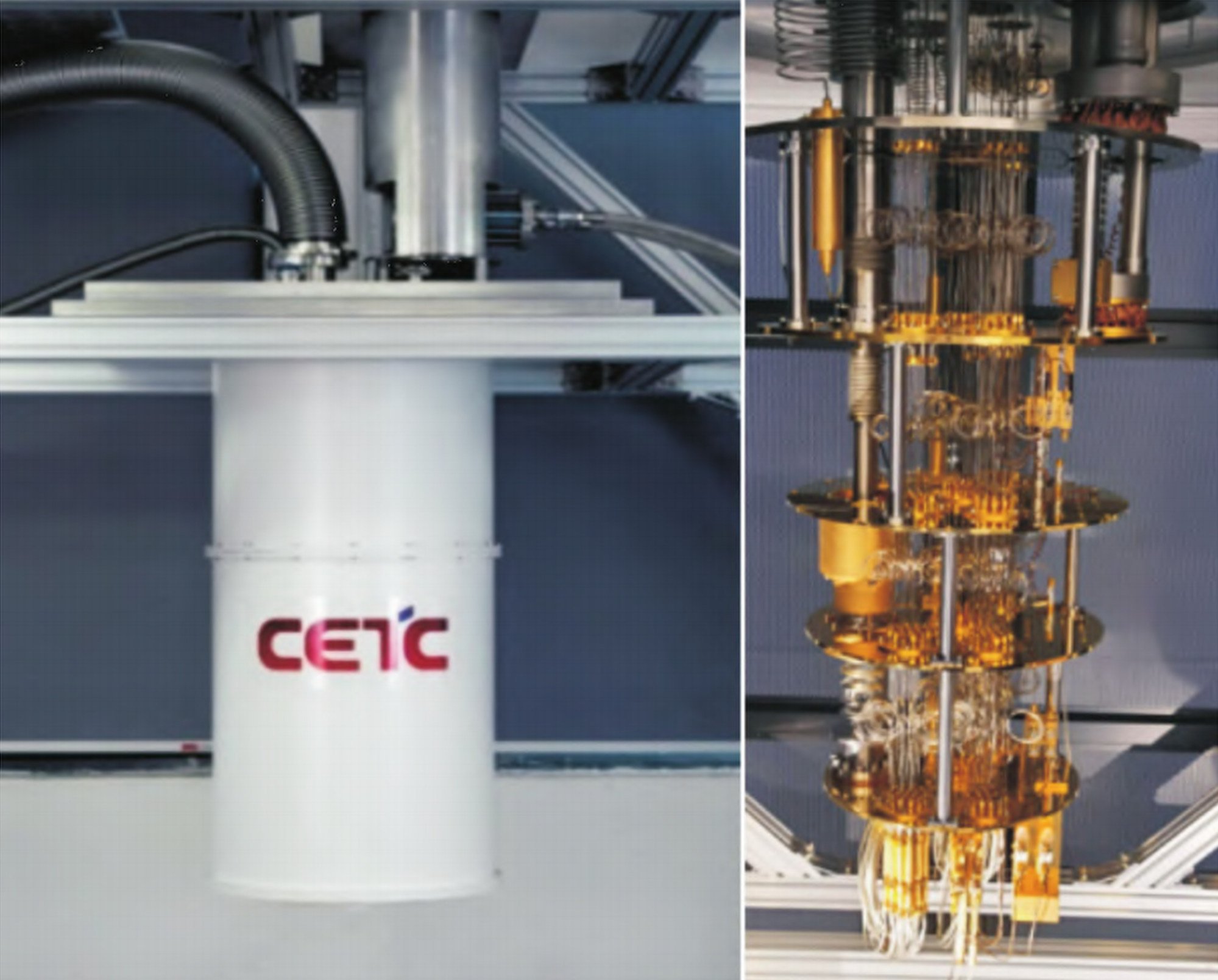联合研究和学术交流受限,我国机构独立开展量子计算技术研究与产品转化,也同样面临关键核心设备、器件“卡脖子”问题,对美国等西方国家仍有相当依存度。
2021年11月,科创板上市企业国盾量子被美国商务部工业与安全局(BIS)列入实体清单,该公司对外回应中坦言:“国内部分高端仪器设备研发周期较长、技术壁垒高,现阶段公司部分高端仪器仍有对外进口依赖,有可能对公司后续经营造成不利影响”,经历该事件后,公司主要募投项目也出现了大幅调减投资金额,推迟建成时间的现象。
顾成建分析,以目前技术上最为成熟的超导量子计算机为例,在稀释制冷机、高性能示波器等量测设备、特种线缆、极低温电子元器件上均存在较为明显的短板,贸易禁运和技术封锁会带来较大影响,
如稀释制冷机“这个设备目前全球只有两家公司真正能提供商用产品,两家加起来占了99%的市场份额,一家就是芬兰的BlueForce,一家是英国的牛津仪器,但从去年下半年开始,这两家已经在美国要求之下,也对中国进行了禁运禁售”。
顾成建还谈到,目前,国内也有多家科研院所和初创企业在量子计算领域关键核心设备、器件上展开攻关,但正如在国内半导体产业所看到的,全部补上基础能力短板尚待时日。
如果说基础创新上短板明显,那么在量子计算机系统和应用层面,中国机构的创新能力目前又处在怎样的水平?能否成为大算力芯片遭限后的“速效救芯丸”?
“这个形势非常的严峻”
“量子计算机目前的发展程度相当于什么阶段的经典计算机?”
对于这个问题,顾成建给出的判断是“相当于仙童公司成立前”(上世纪五十年代)。他指出,目前尽管国内外多家机构研制的系统已经相继宣布实现了“量子优越性”,但基本不具备实用意义,接下来至少5到10年时间,学术与工业界仍然需要向NISQ(含噪声中等规模量子)的目标攀登。至少要进入2030年代,才能看到可编程的通用量子计算机前景。
也正是由于量子计算机距离实用尚远,此前通过SPAC实现公开上市的Rigetti、IonQ、D-Wave等“网红”量子计算企业,均出现了市值大幅萎缩,Rigetti甚至近期曝出濒临退市。顾成建指出,量子计算这个赛道确实出现了严重的一二级市场估值倒挂,甚至有二级市场估值缩水十倍的案例,在他看来,没有可供商业化的成果,没有切实的收入支撑,是导致这一现象的主因。
不过即便如此,In-Q-Tel等美国政府资金加持的基金,仍然在这一领域坚持“投早、投小”,美国量子计算企业吸收风险投资的比例也高踞全球第一,相比之下,我国该领域初创企业吸收投资甚至不及加拿大、英国。顾成建也感言,目前国内民间资本对量子赛道的关注和支持还非常不足。
在量子计算机开发的“马拉松”竞赛中,蓝色巨人IBM目前占据明显领先地位,去年11月,该公司公布了可操作433量子比特位的新一代量子计算机Osprey,也强烈震撼了国内同行。
顾成建表示,
尽管一直以来外界都是把中美并列为量子计算机研发的第一梯队,认为两国并驾齐驱,但在IBM去年公开Osprey后,“我们突然发现中国跟美国的差距至少落后了有一年半到两年的时间,这个代差非常之大,我们还在实验室阶段就已经落后了两代,这个形势非常的严峻”。
在同样不存在清晰的商业回报,相当程度上依赖政府扶持的情况下,
中美两国量子计算机整机研发差距不减反增。在顾成建看来,这既与IBM等巨头的深厚技术积累和工程经验有关,也反映出国内当下一些发人深思的生态弊端。
作为目前国内承担科研课题、专项的主体,各大科研院所在量子计算机研发上仍然相当割裂,尚未实现成果与知识的充分交流共享,各自闭门重造轮子,“没有一个合作的氛围在,没有真正把举国体制用起来,围绕一个目标去做一件事情”。
顾成建还谈到,国内企业相较IBM、英特尔等海外厂商,也显得较为缺乏长期投入的战略定力,在股权投资或地方政府出于各自短期利益的推动下,企业往往也存在夸大宣传的情况。
在量子计算业已被各主要国家视为未来战略制高点的情况下,“起了个大早”的中国,如何能够避免“赶了个晚集”,再次被欧美甩开?
顾成建认为,在需要长期坚持、持续迭代的量子计算机整机研发上,可以通过组建专门的国家实验室,整合全国学术界、工业界资源,破解当前种种弊病,充分释放我国举国体制的特殊优势。量子计算机上游设备、器件,则可以通过市场化手段,吸引设备和器件厂商充分的参与进来,加速产业化进程。
结语
国内尚显稚嫩的量子计算机,虽然难以成为破解美国科技遏制的“速效救芯丸”,但却已日渐显现广阔的未来应用前景,这恐怕也是美国方面将之列为管制重点的原因所在。从先进半导体到量子计算、人工智能,美国正试图牢牢“封死”其竞争对手挖掘利用数据价值的能力。
在复杂严峻的战略技术博弈中,量子计算这一中美间力量对比相对接近的领域,或许可以扮演“破局”的关键,而实现这样的突破,则尚需产业政策更精准、更高效的推动。
Joint research and academic exchanges are limited, and Chinese institutions independently carry out quantum computing technology research and product transformation. They also face the problem of "stuck necks" in key core equipment and devices, and are still quite dependent on the United States and other Western countries.
In November 2021, Guodun Quantum, a company listed on the Science and Technology Innovation Board, was included in the entity list by the Bureau of Industry and Security (BIS) of the U.S. Department of Commerce. At this stage, some of the company's high-end instruments still rely on foreign imports, which may have an adverse impact on the company's subsequent operations." After experiencing this incident, the company's main fundraising projects also experienced a significant reduction in investment amount and delayed completion time.
Gu Chengjian analyzed that taking the most mature superconducting quantum computer as an example, there are obvious shortcomings in dilution refrigerators, high-performance oscilloscopes and other measurement equipment, special cables, and extremely low-temperature electronic components. For example, there are only two companies in the world that can really provide commercial products for this equipment, such as dilution refrigerators. The two companies together account for 99% of the market share. One is BlueForce of Finland, and the other is BlueForce. Oxford Instruments in the United Kingdom, but since the second half of last year, these two companies have also imposed an embargo on China at the request of the United States."
Gu Chengjian also mentioned that at present, there are many scientific research institutes and start-up companies in China that are working on key core equipment and devices in the field of quantum computing. time.
If there are obvious shortcomings in basic innovation, what is the current level of innovation capabilities of Chinese institutions in terms of quantum computer systems and applications? Can it become a "quick-acting rescue pill" after the large computing power chip is restricted?
"The situation is very serious"
"At what stage is the current development of quantum computers equivalent to classical computers?"
Regarding this issue, Gu Chengjian's judgment is "equivalent to before the establishment of Fairchild Company" (in the 1950s). He pointed out that although the systems developed by many institutions at home and abroad have successively announced the realization of "quantum superiority", they are basically not of practical significance. In the next 5 to 10 years, the academic and industrial circles still need to submit to NISQ (including noise medium-scale quantum) for target climbing. The prospect of a programmable universal quantum computer will not be seen until at least the 2030s.
It is precisely because quantum computers are still far from being practical. The "Internet celebrity" quantum computing companies such as Rigetti, IonQ, and D-Wave, which have been publicly listed through SPACs, have experienced a sharp decline in market value. Rigetti has even recently revealed that it is on the verge of delisting. Gu Chengjian pointed out that the quantum computing track has indeed experienced a serious inversion of the primary and secondary market valuations, and there are even cases where the secondary market valuation has shrunk ten times. In his opinion, there are no commercial results and no practical results Income support is the main reason for this phenomenon.
But even so, In-Q-Tel and other funds supported by US government funds still insist on "investing early and investing small" in this field, and the proportion of US quantum computing companies absorbing venture capital is also the highest in the world. Under the current situation, my country's start-ups in this field absorb less investment than Canada and the United Kingdom. Gu Chengjian also said that the attention and support of domestic private capital to Quantum Track is still very insufficient.
In the "marathon" competition for quantum computer development, the blue giant IBM currently occupies a clear leading position. In November last year, the company announced a new generation of quantum computer Osprey that can operate 433 qubits, which also strongly shocked the domestic counterparts.
Gu Chengjian said that although the outside world has always regarded China and the United States as the first echelon of quantum computer research and development, and believed that the two countries are neck and neck, but after IBM released Osprey last year, "We suddenly found that the gap between China and the United States is at least a year and a half behind. In two years, the generational gap is very large, and we are still two generations behind in the laboratory stage, and this situation is very serious.”
In the absence of a clear commercial return and a considerable degree of reliance on government support, the gap in the development of quantum computers between China and the United States has not decreased but increased. In Gu Chengjian's view, this is not only related to the profound technical accumulation and engineering experience of giants such as IBM, but also reflects some thought-provoking ecological disadvantages in China.
As the subject of scientific research projects and special projects in China, major scientific research institutes are still quite fragmented in the research and development of quantum computers. They have not yet realized the full exchange and sharing of results and knowledge, and they reinvent the wheel behind closed doors. "There is no atmosphere of cooperation, there is no Really use the nationwide system to do one thing around one goal."
Gu Chengjian also mentioned that compared with overseas manufacturers such as IBM and Intel, domestic enterprises also seem to lack the strategic determination for long-term investment. Driven by equity investment or local governments for their own short-term interests, enterprises often have exaggerated publicity .
Under the circumstance that quantum computing has been regarded as the commanding heights of the future strategy by major countries, how can China, which "woke up early", avoid "catching up late" and being left behind by Europe and the United States again?
Gu Chengjian believes that in the research and development of quantum computers that require long-term persistence and continuous iteration, it is possible to set up a special national laboratory and integrate the resources of academia and industry across the country to solve the current ills and fully release the special advantages of my country's national system. Quantum computer upstream equipment and devices can attract equipment and device manufacturers to participate fully through market-oriented means to accelerate the industrialization process.
epilogue
Although the still immature quantum computer in China is difficult to become a "quick rescue pill" to break the containment of American technology, it has gradually shown broad future application prospects. This is probably the reason why the United States has listed it as the focus of control. From advanced semiconductors to quantum computing and artificial intelligence, the United States is trying to firmly "seal" its competitors' ability to mine and utilize data value.
In the complex and severe strategic technology game, quantum computing, a field in which the balance of power between China and the United States is relatively close, may play the key to "breaking the game". However, to achieve such a breakthrough, industrial policies need to be more precise and efficient. .


